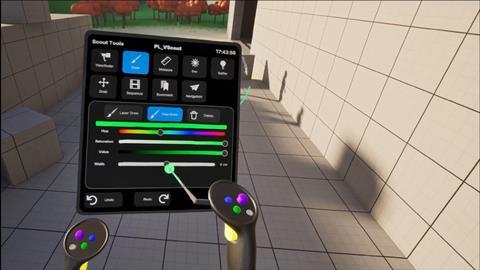A number of virtual production tools are also updated and introduced

Epic Games has launched Unreal Engine 5.4, with further support for media and entertainment tools than previous iterations.
One of the main additions of the update is Motion Design mode, which had earlier been known as Avalanche during its development. Motion Design mode features a number of specialised tools for the creation of complex 2D motion graphics - including 3D cloners, effectors, modifiers, animators, and more. It was created in conjunction with production testing and feedback from broadcasters.
Meanwhile, virtual production tools also feature, including an update to the virtual camera tool that means it is now described as “production-ready”. It also adds Android support and its workflows are also now fully supported in Unreal Engine on macO. The mobile app has been renamed Unreal VCam and is available on the Apple Store and Google Play.
VR Scouting has been updated to include an experimental fully customisable toolkit that utilises XR Creative Framework to support OpenXR HMDs—such as Oculus and Valve Index. For ICVFX, a new Depth of Field Compensation feature means users can accurately control the amount of DOF falloff of the digital content rendered by nDisplay as seen by the movie camera, yielding better results for close-up beauty shots.

Finally, Epic has added Multi-Process Inner Frustum, enabling the render of what’s seen by the movie camera to be split across more GPUs and hardware resources, alongside numerous stability improvements and other enhancements to SMPTE 2110 support - which it says is moving closer to production-ready status.
In addition to these broadcast and virtual production-related changes, there have also been many animation updates. These allow users to rig characters and author animation directly in engine, a feature that enables fine details such as cracks and bumps to be added at render time, and an improvement to render performance.

There is also the addition of Movie Render Graph, for users creating linear content, such as that in TV and film. The node-based architecture enables users to set up graphs to render a single shot, or design them to scale out across complex multi-shot workflows for large teams of artists. Graphs are pipeline-friendly, with Python hooks for studios to build tools and automations. It also introduces Render layers, which offers the ability to generate high-quality elements for post compositing—such as separating foreground and background elements—with support for both the Path Tracer and the Deferred Renderer.
There is also the introduction of Unreal Cloud DDC, a self-hosted cloud storage system for Unreal Engine Derived Data Cache (DDC) designed for distributed users and teams using public network connections. It automatically replicates data between multiple regional Unreal Cloud DDC hosted endpoints, enabling users to always connect to the closest one available. Protected by OIDC login and authentication, the system has been production-tested on AWS at Epic, and also comes with deployment instructions for Azure. There are also enhancements for Epic’s local DDC, which now uses Unreal Zen Storage server architecture.
You can see a video from Epic Games outlining the main features below.





No comments yet